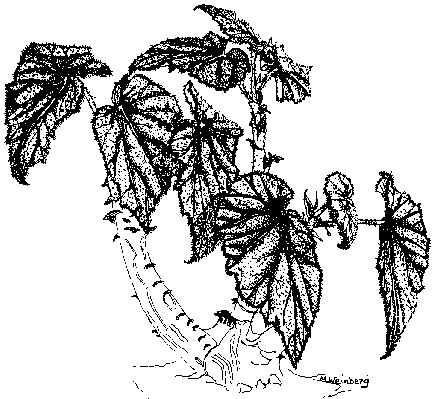B. dipetala (dye-pet-al-ah) was first discovered in Bombay, India in 1826 by H. H. Johnstone, and first described by Graham in 1828. It was introduced accidentally into the U.S. as B. ‘Mrs. W.S. Kimball’ in 1913. It is in section Haagea and has 30 chromosomes.
B. dipetala is a thick-stemmed begonia. Its stem is erect and tapering, greyish brown in color. Leaves are medium-sized, grass green, obliquely ovate, semi-cordate, acute at the tip, and have a red sinus with the red radiating down indented veins and fading into green. Leaves are minutely pustulate, having white spots at the tip of pustules with a short white bristly hair coming from the center of each pustule. Both staminate and pistillate flowers have two tepals, the female ovary has three subequal wings, flowers are on semi-erect peduncles that tend to droop as they age. Flowers are white tinged with pink. B. dipetala blooms February through September.
In early literature, B. dipetala is described as being a variety of B. malabarica. Now it has been determined to be a separate species.
It is a good thing we know that B. dipetala came from the Bombay area, as India has three types of climate including very large areas of arid land where almost nothing grows. Bombay is on the west coast of India, located close to the Western Ghats range of mountains. This area has a very heavy annual rainfall, over 80 inches, and in some areas up to 400 inches annually. The rainy season is from July to October. The soil in this area is described as alluvial (soil consisting of sand and mud caused by flowing waters). Temperatures in this area average 68 degrees F. in the cold season (Nov.- Feb.), to 86 degrees F. during the hot season (March- June).
I have had B. dipetala for several years, and recently acquired another plant from a member who was moving. Both plants were kept outside in the summer greenhouse from early June until mid-September; they put on many leaves which gave them a rounded appearance. When fall came I brought them inside, putting my first and smallest plant in the upstairs light garden (cool conditions in the fall) and the larger plant in the basement light garden (very warm condition in the fall). The plant in the warm basement atmosphere continued to thrive and did not lose leaves, while the plant in the upstairs light garden lost many of its lower leaves. I think this demonstrates very well B. dipetala‘s preference for warm situations.
B. dipetala is very compact in its growth habits, growing to a height of about 18 inches. It does not branch readily; its main stem is rough in texture and very thick at the base. It can be used very successfully as a subject for bonsai.
CULTURE
Light: B. dipetala likes bright light, but like most hairy begonias it must be protected from the hot midday sun. Give filtered light during this part of the day.
Temperature: B. dipetala likes a warm environment. 65 degrees to 80 degrees is an ideal range, but it can tolerate temperatures slightly higher or lower than the ideal.
Humidity: 50% to 60% is good. It does not need terrarium care.
Growing Medium: Use a very porous mix for good drainage. Pot in clay pots; they are best for the thick-stemmed begonias, as they allow for evaporation of water through the sides of the pot.
Water: Do not water until the surface of the growing medium feels dry to the touch. Water well, letting water run out of the bottom of the pot. Do not let pot stand in water for more than a few minutes.
This article first appeared in the Chicago Begonian, December, 1984. It was reprinted with the author’s permission.


